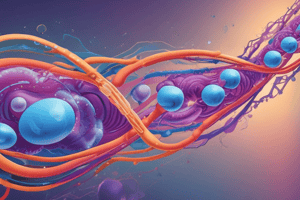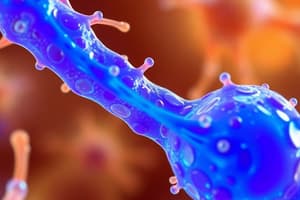Podcast
Questions and Answers
What role does the cytoskeleton serve in the cell?
What role does the cytoskeleton serve in the cell?
- It acts as the primary site for energy production.
- It provides structural support and organization. (correct)
- It is responsible for cell division.
- It acts as a barrier against pathogens.
Which cytoskeletal element is crucial for intracellular transport?
Which cytoskeletal element is crucial for intracellular transport?
- Microtubules (correct)
- Ciliary filaments
- Microfilaments
- Intermediate filaments
What type of junctions prevent leaks between epithelial cells?
What type of junctions prevent leaks between epithelial cells?
- Adherens junctions
- Desmosomes
- Tight junctions (correct)
- Gap junctions
Which component of the extracellular matrix is known as a biological ‘glue’?
Which component of the extracellular matrix is known as a biological ‘glue’?
What function do microfilaments serve in the cytoskeleton?
What function do microfilaments serve in the cytoskeleton?
What is the main advantage of gap junctions in cellular communication?
What is the main advantage of gap junctions in cellular communication?
Intermediate filaments are best associated with which of the following functions?
Intermediate filaments are best associated with which of the following functions?
Which of these proteins is NOT a major component of the extracellular matrix?
Which of these proteins is NOT a major component of the extracellular matrix?
What is the primary function of mitochondria in eukaryotic cells?
What is the primary function of mitochondria in eukaryotic cells?
What role does the rough endoplasmic reticulum play in the cell?
What role does the rough endoplasmic reticulum play in the cell?
How are individual genes regulated in response to cellular context?
How are individual genes regulated in response to cellular context?
What differentiates prokaryotic cells from eukaryotic cells?
What differentiates prokaryotic cells from eukaryotic cells?
What function do lysosomes perform within a cell?
What function do lysosomes perform within a cell?
What is a consequence of mitochondrial metabolism leakage?
What is a consequence of mitochondrial metabolism leakage?
Which metabolic pathway do cells rely on during oxygen deficiency?
Which metabolic pathway do cells rely on during oxygen deficiency?
Which type of cellular component is responsible for the storage of fat and glycogen?
Which type of cellular component is responsible for the storage of fat and glycogen?
Flashcards
Universal components of cells
Universal components of cells
The fundamental building blocks of all living organisms, comprising water, inorganic chemicals, carbohydrates, lipids, proteins, and nucleic acids.
Nucleus
Nucleus
A cellular structure that houses the cell's genetic material (DNA) and regulates its activities.
Protein synthesis
Protein synthesis
The process of converting the genetic code within DNA into a functional protein.
Transcription
Transcription
Signup and view all the flashcards
Translation
Translation
Signup and view all the flashcards
Mitochondria
Mitochondria
Signup and view all the flashcards
Glycolysis
Glycolysis
Signup and view all the flashcards
Cytoplasm
Cytoplasm
Signup and view all the flashcards
What are lysosomes and what functions do they serve?
What are lysosomes and what functions do they serve?
Signup and view all the flashcards
How do free radicals contribute to aging, and how do long-lived organisms combat them?
How do free radicals contribute to aging, and how do long-lived organisms combat them?
Signup and view all the flashcards
Distinguish between cellular respiration, oxidative phosphorylation, and chemiosmosis.
Distinguish between cellular respiration, oxidative phosphorylation, and chemiosmosis.
Signup and view all the flashcards
How would you determine if the recovered Loriciferans are truly living in a deep sea anaerobic environment?
How would you determine if the recovered Loriciferans are truly living in a deep sea anaerobic environment?
Signup and view all the flashcards
Is iPSC technology the 'fountain of youth'? How do embryonic genes reprogram a differentiated cell?
Is iPSC technology the 'fountain of youth'? How do embryonic genes reprogram a differentiated cell?
Signup and view all the flashcards
How would you determine the approximate age of a woolly mammoth hair and how might you attempt to resurrect a living mammoth?
How would you determine the approximate age of a woolly mammoth hair and how might you attempt to resurrect a living mammoth?
Signup and view all the flashcards
What elements could replace oxygen as a final electron acceptor in respiration and what are the advantages and disadvantages of using them?
What elements could replace oxygen as a final electron acceptor in respiration and what are the advantages and disadvantages of using them?
Signup and view all the flashcards
What is the cytoskeleton and what are its different components and functions?
What is the cytoskeleton and what are its different components and functions?
Signup and view all the flashcards
Study Notes
Cellular Components and Processes
- Cells are composed of water, inorganic chemicals, carbohydrates, lipids, proteins, and nucleic acids.
- Macromolecular structures require flexibility and protection for proper function, which is a part of homeostasis.
- Prokaryotic cells (archaeal and bacterial) have a simpler structure than eukaryotic cells, lacking a nucleus and most organelles. Eukaryotic cells are divided into the plasma membrane, nucleus, and cytoplasm with various organelles.
- DNA holds genetic codes for protein synthesis via transcription and translation. Genes are differentially expressed in different tissues and organs. Gene regulation occurs via promoters and transcription factors, as well as tissue-specific transcription factors expressed during development. Genome projects use various experimental methods to explore gene-cell interactions.
- The endoplasmic reticulum, either rough (protein secretion and membrane construction) or smooth (protein packaging), plays a role in protein transport. The Golgi complex processes proteins further, packaging them for exocytosis.
- Lysosomes digest extracellular material (phagocytosis), while proteasomes break down intracellular proteins.
- Mitochondria are the cell's energy source (power plants), converting food energy into ATP. Electron leakage from mitochondrial metabolism can cause damage and contribute to aging.
- Cells rely on anaerobic reactions (glycolysis) when oxygen is low, producing lactate, propionic acid, octopine, or other end products. This tolerance varies among tissues and organisms.
- The cytosol is involved in intermediary metabolism, protein synthesis, and fat/glycogen storage.
- The cytoskeleton, a protein network, provides support, organization, and regulates cellular component movement. Microtubules (largest) control transport, cilia, and flagella; microfilaments (smallest) are involved in contractile systems and support; intermediate filaments are crucial in mechanically stressed regions.
- The extracellular matrix (ECM) is a fibrous protein meshwork in interstitial fluid, providing structural support and connections between cells (e.g., collagen, elastin, fibronectin).
- Cells connect via specialized junctions: desmosomes (cell-cell adhesion); tight junctions (epithelial tissue sealing); and gap junctions (small molecule passage).
Organelle Function and Enzymes
- Lysosomes and proteasomes act as the intracellular digestive systems.
- Lysosomes contain enzymes for digesting extracellular materials.
- Proteasomes break down intracellular proteins.
Free Radicals and Aging
- Free radicals, byproducts of mitochondrial metabolism, can potentially contribute to cellular damage and aging.
- Species with longer lifespans may have mechanisms to counteract free radical-associated degeneration.
Cellular Respiration, Oxidative Phosphorylation, and Chemiosmosis
- These terms are related to cellular energy processes involving oxygen and energy production.
Anaerobic Environments
- Determining if organisms survived in anaerobic environments instead of simply dying after drifting down involves investigating the cells' metabolic state as opposed to their overall viability.
iPSC (Induced Pluripotent Stem Cells) Technology and Aging
- iPSC technology might not be a "fountain of youth".
- Mechanisms of embryonic gene expression could reprogram differentiated cells.
Determining Mammoth Age and Resurrection
- Wooly mammoth hair age can be estimated using radiocarbon dating.
- Mammoth resurrection is a difficult task involving the determination of the DNA and cellular composition to develop a suitable organism that can be cloned.
Oxygen as a Double-Edged Sword and Alternative Electron Acceptors
- Oxygen is vital for cellular respiration but generates free radicals.
- Alternate final electron acceptors could be used, with potential advantages and disadvantages in terms of energy yield and radical production.
Studying That Suits You
Use AI to generate personalized quizzes and flashcards to suit your learning preferences.




